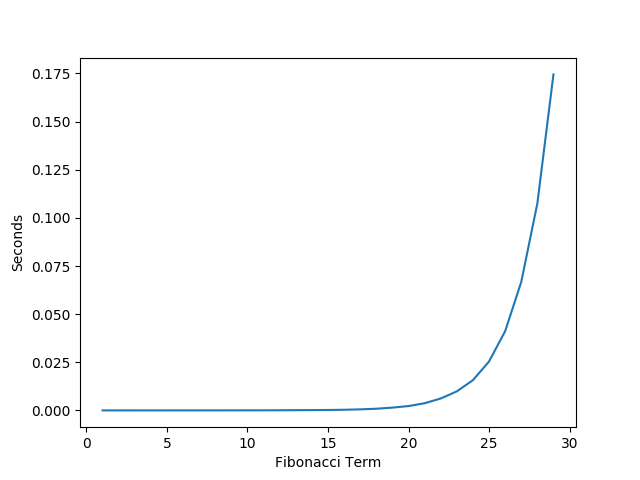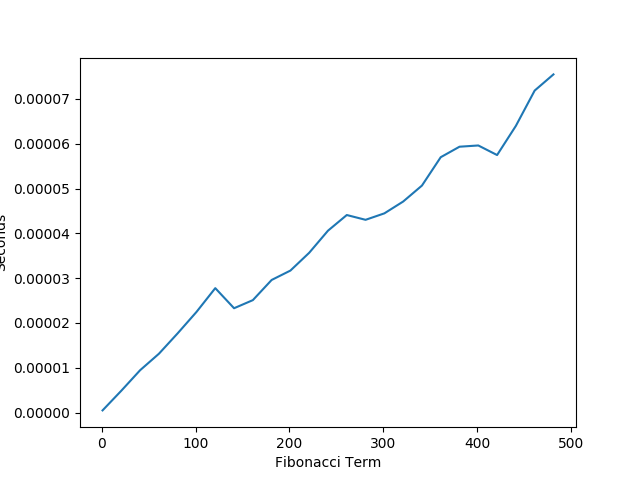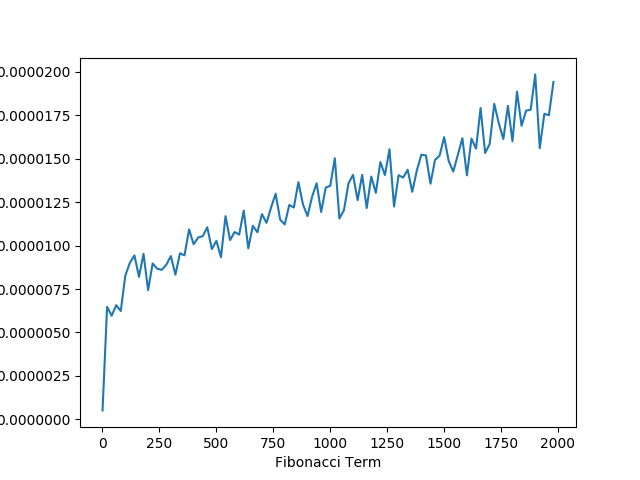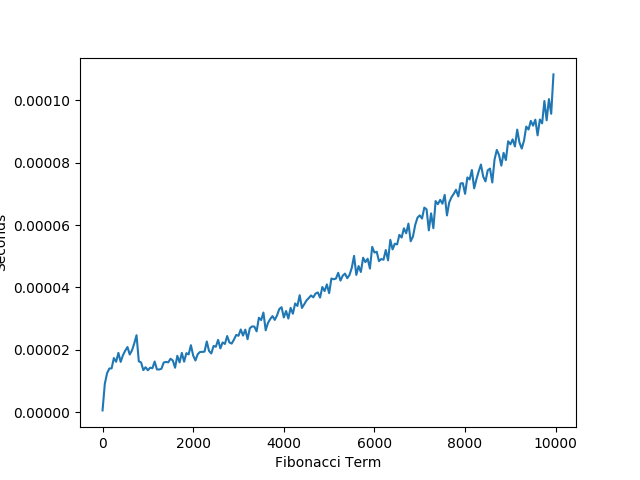9.7 KiB
If you have ever taken a computer science class you probably know what the fibonacci sequence is and how to calculate it. For those who don't know: Fibonacci is a sequence of numbers starting with 0,1 whose next number is the sum of the two previous numbers. After having multiple of my CS classes gave lectures and multiple homework on the Fibonacci sequence; I decided that it would be a great idea to write a blog post going over the 4 main ways of calculating the nth term of the Fibonacci sequence. In addition to providing python code for calculating the nth perm of the sequence, a proof for their validity and analysis of their time complexities both mathematically and empirically will be examined.
Slow Recursive Definition
By the definition of the Fibonacci sequence, it is the most natural to write it as a recursive definition.
def fib(n):
if n == 0 or n == 1:
return n
return fib(n-1) + fib(n-2)
##Time Complexity
Observing that each call has two recursive calls we can place an upper bound on this function as $O(2^n)$. However, if we solve this recurrence we can compute the exact value and place a tight bound for time complexity.
We can write a recurrence for the number of times fib is called:
$$
F(0) = 0\
F(1) = 1\
F(n) = F(n-1) + F(n-2)\
$$
Next we replace each instance of F(n) with $a^n$ since we want to solve for the roots since that will allow us to put a tight asymptotic limit on the growth.
$$
a^n = a^{n-1} + a^{n-2}\
\frac{a^n}{a^{n-2}} = \frac{a^{n-1} + a^{n-2}}{a^{n-2}}\
a^2 = a + 1\
a = \frac{1 + sqrt(5)}{2}\
$$
From this calculation we can conclude that F(n) $\in \Theta 1.681^n$
Measured Performance
Here is a graph of the actual performance that I observed from this recursive definition of Fibonacci.
Accumulation Solution
The problem with the previous recursive solution is that you had to recalculate certain terms of fibonacci a ton of times. A summation variable would help us avoid this problem. You could write this using a simple loop, however, it is still possible to do this with recursion.
def fibHelper(n, a, b):
if n == 0:
return a
elif n == 1:
return b
return fibHelper(n-1, b, a+b)
def fibIterative(n):
return fibHelper(n, 0, 1)
In this code example fibHelper is a method which accumulates the previous two terms. The fibIterative is a wrapper method which sets the two initial terms equal to 0 and 1 representing the fibonacci sequence.
Proof for Fib Helper
Lemma: For any n $\epsilon$ N if n $>$ 1 then $fibHelper(n, a, b) = fibHelper(n - 1, a, b) + fibHelper(n - 2, a, b)$.
Proof via Induction
Base Case: n = 2:
$$
LHS = fibHelper(2, a, b)\
= fibHelper(1, b, a + b) = a + b\
RHS = fibHelper(2 -1, a, b) + fibHelper(2-2, a, b)\
= a + b\
$$
Inductive Step:
Assume proposition is true for all n and show n+1 follows.
$$
RHS=fibHelper(n+1;a,b)\
= fibHelper(n;b,a+b)\
=fibHelper(n-1;b,a+b) + fibHelper(n-2;b,a+b)\
=fibHelper(n;a,b) + fibHelper(n-1;a,b)\
=LHS\
$$
$\Box$
Proof That fibIterative = Fib
Lemma: For any n $\in$ N, $fib(n)$ = $fibIterative(n, 0, 1)$
Proof via Strong Induction
Base Case: n = 0:
$$
fibIterative(0, 0, 0) = 0\
= fib(0)
$$
Base Case: n = 1:
$$
fibIterative(1, 0, 0) = 1\
= fib(1)
$$
Inductive Step:
Assume proposition is true for all n and show n+1 follows.
$$
fib(n+1) = fib(n) + fib(n-1)\
= fibHelper(n, 0, 1) + fibHelper(n+1, 0 ,1) \quad\text{I.H}\
= fibHelper(n+1, 0, 1) \quad\text{from result in previous proof}\
$$
$\Box$
Time Complexity
Suppose that we wish to solve for time complexity in terms of the number of additions needed to be computed. By observing the algorithm for fibHelper we can see that we perform one addition every time which we have a recursive call. We can now form a recurrence for time complexity and solve for it.
$$
T(0) = 0\
T(1) = 0\
T(n) = 1 + T(n-1)\
T(n) = n-1\
$$
From this recurrence we can say that fibHelper $\in \Theta(n)$.
Measured Performance
Notice how much faster this solution is compared to the original recursive solution for Fibonacci.
Matrix Solution
We can actually get better than linear time for performance while calculating the Fibonacci sequence recursively using this fact:
$$
\begin{bmatrix}
1 & 1\
1 & 0
\end{bmatrix}^n =
\begin{bmatrix}
F_{n+1} & F_n\
F_n & F{n-1}
\end{bmatrix}^n
$$
Without any other tricks, raising a matrix to a power n times would not get us better than linear performance. However, if we use the Exponentiation by Squaring method, we can expect to see logarithmic time. Since two spots in the matrix are always equal, I represented the matrix as an array with only three elements.
def multiply(a,b):
product = [0,0,0]
product[0] = a[0]*b[0] + a[1]*b[1]
product[1] = a[0]*b[1] + a[1]*b[2]
product[2] = a[1]*b[1] + a[2]*b[2]
return product
def power(l, k):
if k == 1:
return l
temp = power(l, k//2)
if k%2 == 0:
return multiply(temp, temp)
else:
return multiply(l, multiply(temp, temp))
def fibPower(n):
l = [1,1,0]
return power(l, n)[1]
Time Complexity
For this algorythem lets solve for the time complexity as the number of additions and multiplications.
Since we are always multiplying two 2x2 matrices, that is constant time.
$$ T_{multiply} = 9 $$
Solving for the time complexity of fib power is slightly more complicated.
$$
T_{power}(1) = 0\
T_{power}(n) = T(\left\lfloor\dfrac{n}{2}\right\rfloor) + T_{multiply}\
= T(\left\lfloor\dfrac{n}{2}\right\rfloor) + 9\
= T(\left\lfloor\dfrac{n}{2*2}\right\rfloor) + 9 + 9\
= T(\left\lfloor\dfrac{n}{2*2*2}\right\rfloor) + 9+ 9 + 9\
T_{power}(n) = T(\left\lfloor\dfrac{n}{2^k}\right\rfloor) + 9k\
$$
let $k=k_0$ such that $\left\lfloor\dfrac{n}{2^{k_0}}\right\rfloor = 1$
$$
\left\lfloor\dfrac{n}{2^{k_0}}\right\rfloor = 1 \rightarrow 1 \leq \frac{n}{2^{k_0}} < 2\
\rightarrow 2^{k_0} \leq n < 2^{k_0 +1}\
\rightarrow k_0 \leq lg(n) < k_0+1\
\rightarrow k_0 = \left\lfloor lg(n)\right\rfloor\
T_{power}(n) = T(1) + 9*\left\lfloor lg(n)\right\rfloor\
T_{power}(n) = 9*\left\lfloor\ lg(n)\right\rfloor\
T_{fibPower}(n) = T_{power}(n)\
$$
Inductive Proof for Matrix Method
Lemma: For any n $\epsilon$ N if n $>$ 0 then
$$
\begin{bmatrix}
1 & 1\
1 & 0
\end{bmatrix}^n =
\begin{bmatrix}
F_{n+1} & F_n\
F_n & F{n-1}
\end{bmatrix}^n
$$
Let
$$
A=
\begin{bmatrix}
1 & 1\
1 & 0
\end{bmatrix}^n
$$
Base Case: n = 1
$$
A^1=
\begin{bmatrix}
1 & 1\
1 & 0
\end{bmatrix}^n =
\begin{bmatrix}
F_{2} & F_2\
F_2 & F_{0}
\end{bmatrix}^n
$$
Inductive Step: Assume proposition is true for n, show n+1 follows
$$
A^{n+1}=
\begin{bmatrix}
1 & 1\
1 & 0
\end{bmatrix}
\begin{bmatrix}
F_{n+1} & F_n\
F_n & F{n-1}
\end{bmatrix}^n\
= \begin{bmatrix}
F_{n+1} + F_n & F_n + F_{n-1}\
F_{n+1} & F_{n}
\end{bmatrix}\
= \begin{bmatrix}
F_{n+2} & F_{n+1}\
F_{n+1} & F_{n}
\end{bmatrix}\
$$
$\Box$
Measured Performance
As expected by our mathmatical calcuations, the algorthem appears to be running in logarithmic time.
Measured Performance With Large Numbers
When calculating the fibonacci term for extremely large numbers dispite having a polynomial time complexity, the space required to compute Fibonacci grows exponentially. Since our performance is only pseudo-polynomial we see a degrade in our performance when calculating large terms of the fibonacci sequence.
The one amazing thing to point out here is that despite calculating the 10,000 term of Fibonacci, this algorithm is nearly 400 times faster than the recursive algorithm when it was calculating the 30th term of Fibonacci.
Closed Form Definition
It is actually possible to calculate Fibonacci in constant time using Binet's Formula.
$$ F_n = \frac{(\frac{1+\sqrt{5}}{2})^n-(\frac{1-\sqrt{5}}{2})^n}{\sqrt{5}} $$
def fibClosedFormula(n):
p = ((1+ math.sqrt(5))/2)**n
v = ((1-math.sqrt(5))/2)**n
return (p-v)/math.sqrt(5)
Derivation of Formula
Similar to when we were calculating for the time complexity, we want to start by finding the two roots of the equation.
$$
a^n = a^{n-1} + a^{n-2}\
\frac{a^n}{a^{n-2}} = \frac{a^{n-1} + a^{n-2}}{a^{n-2}}\
a^2 = a + 1\
0 = a^2 - a - 1\
a = \frac{1 \pm sqrt(5)}{2}\
$$
Since there are two roots to the equation, the solution of $F_n$ is going to be a linear combination of the two roots.
$$ F_n = c_1(\frac{1 + \sqrt{5}}{2})^n + c_2(\frac{1 - \sqrt{5}}{2})^n $$
Fact: $F_1$ = 1
$$
F_1 = 1\
= c_1(\frac{1 + \sqrt{5}}{2}) + c_2(\frac{1 - \sqrt{5}}{2})\
= \frac{c_1}{2} + \frac{c_2}{2} + \frac{c_1\sqrt{5}}{2} - \frac{c_2\sqrt{5}}{2}\
$$
Let $c_1 = \frac{1}{\sqrt{5}}$, Let $c_2 = \frac{-1}{\sqrt{5}}$
$$
F_n = \frac{1}{\sqrt(5)}((\frac{1+\sqrt{5}}{2})^n-(\frac{1-\sqrt{5}}{2})^n)\
= \frac{(\frac{1+\sqrt{5}}{2})^n-(\frac{1-\sqrt{5}}{2})^n}{\sqrt{5}}
$$
Time Complexity
Since we managed to find the closed form of the fibonacci sequence we can expect to see constant performance.





